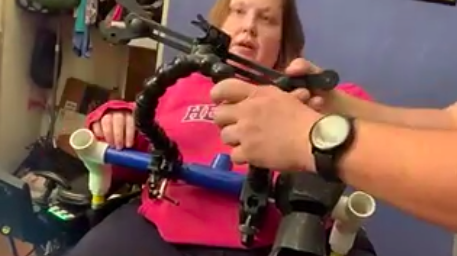Introduction:
On November 3rd, Carl, Arleen, Clair and Mimi meet with Brenda over zoom to conduct an interview. Carl and Mimi are on Team Brenda 1. The purpose of this interview was to learn about some difficulties that Brenda faces in her life and begin ideation about the possible assistive devices we could make with an arduino to fix those problems.
Meeting Agenda:
Introductions
-name, major, year, fun fact, something you enjoy doing
Ask if we can record
Outline of project/ reminders about scope of project (covid-19)
45 min – 1 hour meeting
Questions:
- Q: What drew you to want to participate?
- A:
- Q: Is there anything in particular that you want us to know about/ want us to make for you?
- A:
- Q: Are there any particular difficulties that you face on a regular basis that you would like to describe to us?
- A:
- Q: What is your daily routine like?
- A:
- Q: Have the client try to think of something that they used to enjoy doing, which has become harder over time for any reason
- A:
- Q: is there anything you want us to know about that we haven’t discussed yet?
More Free form questions + extra notes:
Draw ideas on tinkercad/ use whiteboard if needed:
Conclusion:
Meeting Summary:
The meeting started off with introductions and after that Brenda started to share some of the ideas that she had come up with prior to the interview. These ideas included making her iPad stand motorized, creating a way for her to reach the items in her backpack, making it so her foot plates on her wheelchair can automatically flip up and a better phone case. We asked more specific questions about these problems to get a better understanding of what specific features she wanted each device to have. She also showed us what a couple of the things looked like so we could get a better idea of how we needed to construct the project. Afterwards we asked more general questions to learn about what her day to day looks like. When she would describe something that she was having trouble with we would ask more questions to see if this was something we could create an assistive device for. Some of the ideas that came from that discussion were an automatic window opener and closer, and a remote controlled way to turn the water on and off for a bathtub. We then learned more general information about Brenda that will help us design a better device for her. For example, her right side has much more mobility than her left side meaning we should design everything in a way so she can use it with her right hand. Lastly, we concluded the meeting with some thank yous and Brenda promised to send us more photos so we could see the space or item we were designing the device for.

Screenshot of Brenda demonstrating how her backpack hangs off her wheelchair

Major Takeaways:
- One of the biggest takeaways was the scope of the project that will be useful for Brenda. She described her childhood as always trying to figure out different ways to accomplish the tasks she couldn’t do.
- When talking with me in another interview, Brenda explained how she wanted to play the piano. This drive motivated her to get all of the small exercise sessions out of the way in order to just sit at the keys and practice being able to use her left hand to play.
- In her more adult life, she has since figured out various ways to complete the broad scoped projects in her life, getting into the bath, cooking, etc. Where she was struggling was more in the detailed oriented or small scoped projects, opening windows, turning on the bath faucets, reaching her backpack, etc.
Thoughts:
The meeting was very productive. Brenda came into the meeting with several project ideas for us. Her ideas centered around things that would help her be more independent. There were a couple ideas she had that would not have worked in the scope of our project because there was no electrical or arduino component. Afterwards, we asked some more general questions about her routine and daily struggles and that helped us to formulate more ideas for assistive devices. It was really helpful in the interview when Brenda demonstrated the difficult task or showed us where the device would be placed. This helped us to understand the problem better and think of the best solution.